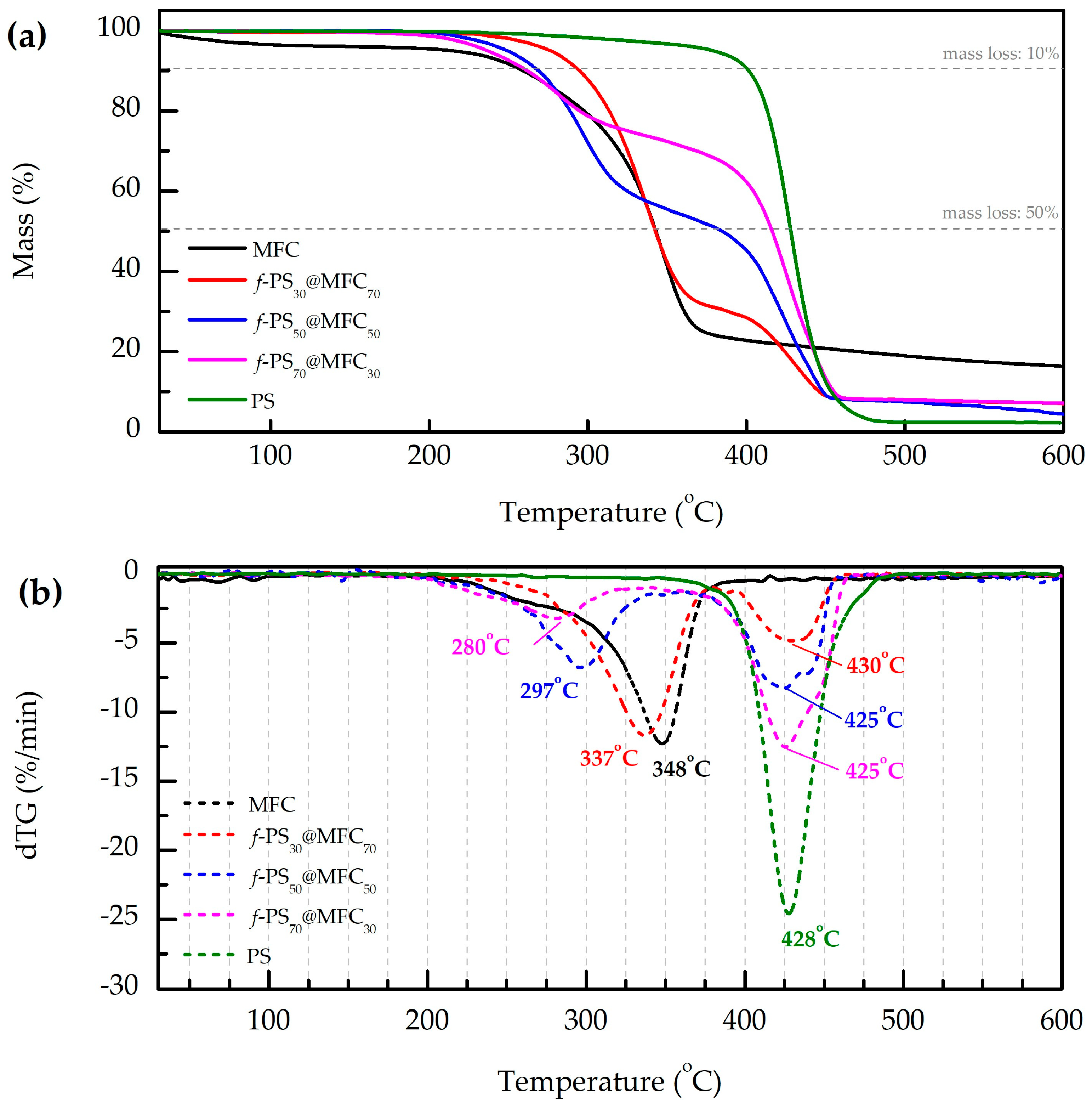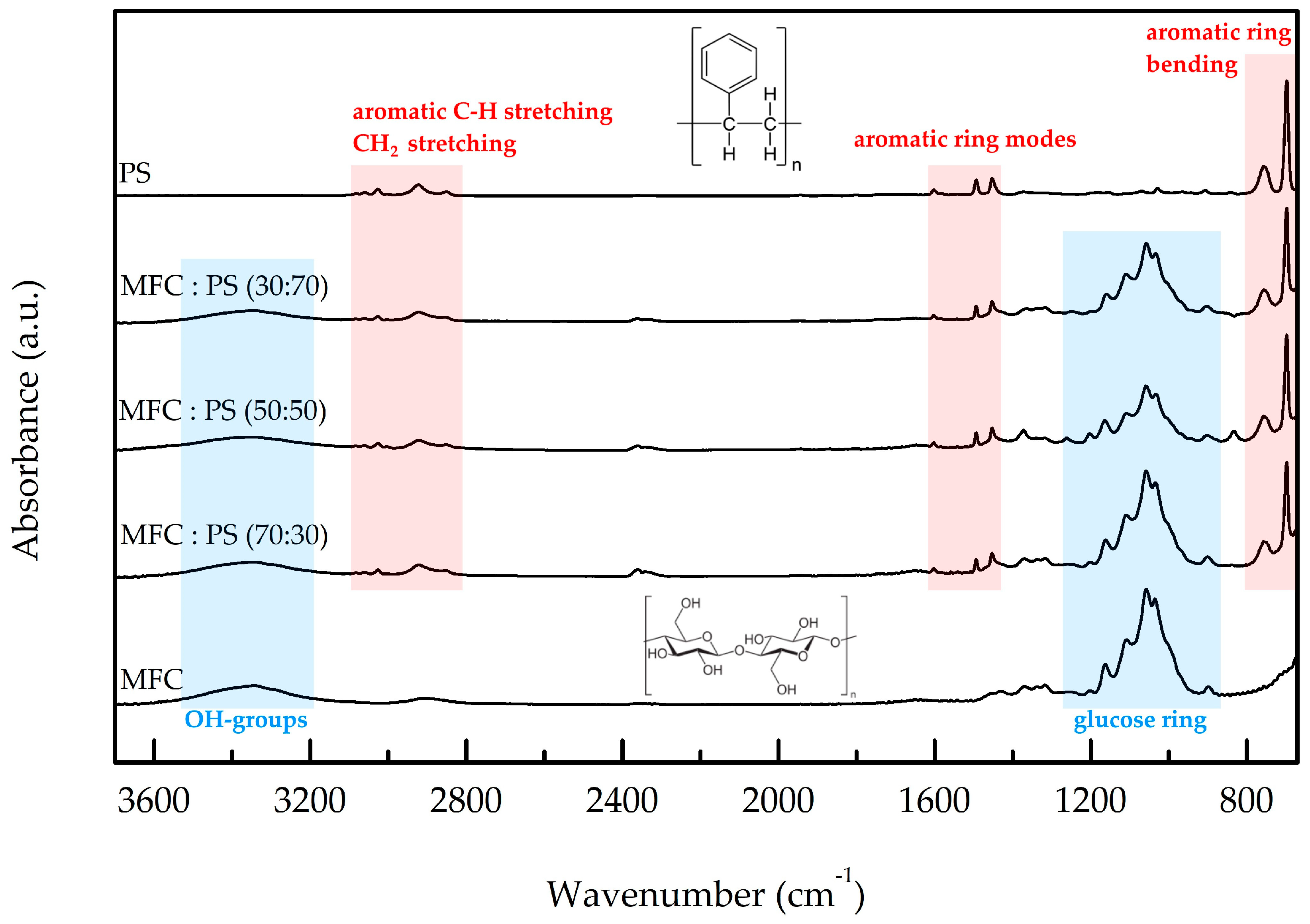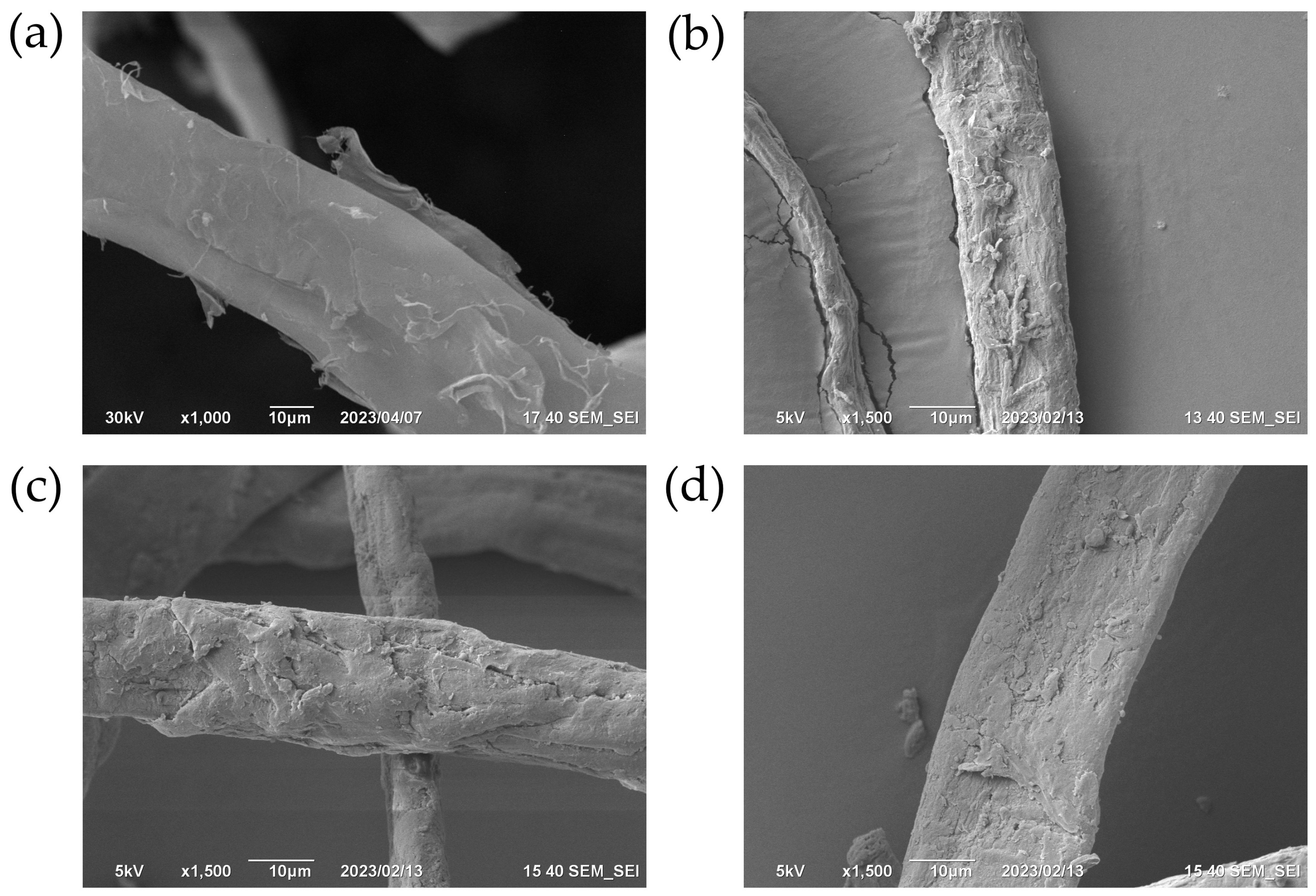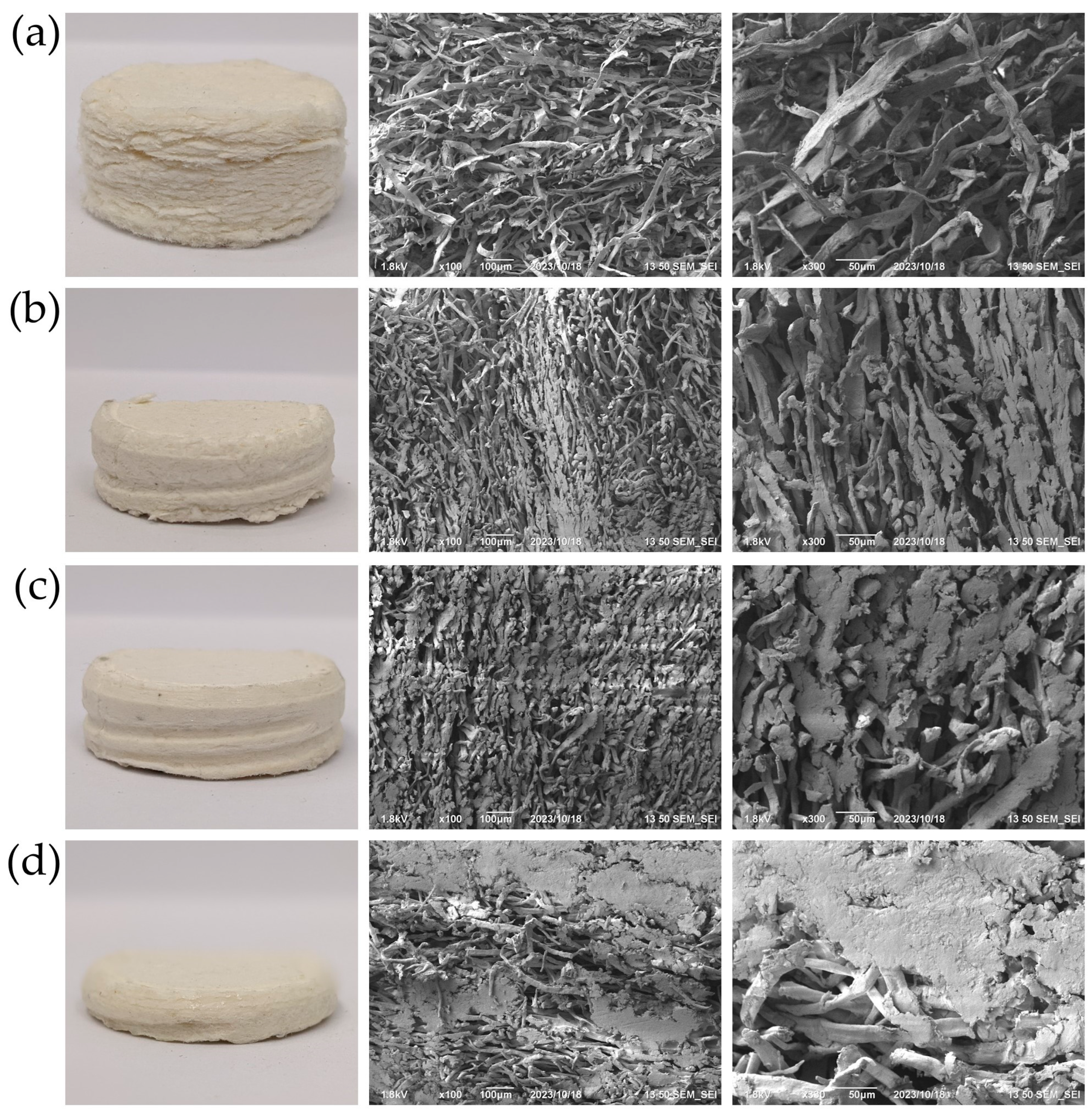A Facile One-Step Synthesis of Polystyrene/Cellulose (PS@MFC) Biocomposites for the Preparation of Hybrid Water-Absorbing Sponge Materials
Abstract
:1. Introduction
2. Materials and Methods
2.1. Raw Materials
2.2. MFC Preparation
2.3. Synthesis of CMF/PS Composite Fibers
2.4. Preparation of Sponge Composite Materials
2.5. Electron Microscopy
2.6. Fourier-Transform Infrared Spectroscopy (FTIR)
2.7. Thermogravimetric Analysis (TGA)
2.8. Differential Scanning Calorimetry (DSC)
2.9. Density, Porosity, and Water Uptake Coefficient of Sponge Composite Materials
3. Results and Discussion
4. Conclusions
Author Contributions
Funding
Institutional Review Board Statement
Data Availability Statement
Acknowledgments
Conflicts of Interest
References
- Yose, P.; Thondhlana, G.; Fraser, G. Conceptualizing the Socio-Cultural Impacts of Marine Plastic Pollution on Human Well-Being—A Perspective. Mar. Pollut. Bull. 2023, 194, 115285. [Google Scholar] [CrossRef] [PubMed]
- Citterich, F.; Lo Giudice, A.; Azzaro, M. A Plastic World: A Review of Microplastic Pollution in the Freshwaters of the Earth’s Poles. Sci. Total Environ. 2023, 869, 161847. [Google Scholar] [CrossRef] [PubMed]
- Frias, J.P.G.L.; Nash, R. Microplastics: Finding a Consensus on the Definition. Mar. Pollut. Bull. 2019, 138, 145–147. [Google Scholar] [CrossRef] [PubMed]
- Moshood, T.D.; Nawanir, G.; Mahmud, F.; Mohamad, F.; Ahmad, M.H.; AbdulGhani, A. Sustainability of Biodegradable Plastics: New Problem or Solution to Solve the Global Plastic Pollution? Curr. Res. Green Sustain. Chem. 2022, 5, 100273. [Google Scholar] [CrossRef]
- Azhary, T.; Kusmono; Wildan, M.W. Herianto Mechanical, Morphological, and Thermal Characteristics of Epoxy/Glass Fiber/Cellulose Nanofiber Hybrid Composites. Polym. Test. 2022, 110, 107560. [Google Scholar] [CrossRef]
- Babaei-Ghazvini, A.; Acharya, B. Crosslinked Poly (Vinyl Alcohol) Composite Reinforced with Tunicate, Wood, and Hybrid Cellulose Nanocrystals: Comparative Physicochemical, Thermal, and Mechanical Properties. Int. J. Biol. Macromol. 2023, 227, 1048–1058. [Google Scholar] [CrossRef]
- Garavand, F.; Cacciotti, I.; Vahedikia, N.; Rehman, A.; Tarhan, Ö.; Akbari-Alavijeh, S.; Shaddel, R.; Rashidinejad, A.; Nejatian, M.; Jafarzadeh, S.; et al. A Comprehensive Review on the Nanocomposites Loaded with Chitosan Nanoparticles for Food Packaging. Crit. Rev. Food Sci. Nutr. 2022, 62, 1383–1416. [Google Scholar] [CrossRef]
- Cataño, F.A.; Moreno-Serna, V.; Cament, A.; Loyo, C.; Yáñez-S, M.; Ortiz, J.A.; Zapata, P.A. Green Composites Based on Thermoplastic Starch Reinforced with Micro- and Nano-Cellulose by Melt Blending—A Review. Int. J. Biol. Macromol. 2023, 248, 125939. [Google Scholar] [CrossRef]
- Mittal, A.; Garg, S.; Bajpai, S. Fabrication and Characteristics of Poly (Vinyl Alcohol)-Starch-Cellulosic Material Based Biodegradable Composite Film for Packaging Application. Mater. Today Proc. 2020, 21, 1577–1582. [Google Scholar] [CrossRef]
- Liu, C.; Luan, P.; Li, Q.; Cheng, Z.; Sun, X.; Cao, D.; Zhu, H. Biodegradable, Hygienic, and Compostable Tableware from Hybrid Sugarcane and Bamboo Fibers as Plastic Alternative. Matter 2020, 3, 2066–2079. [Google Scholar] [CrossRef]
- Nurazzi, N.M.; Asyraf, M.R.M.; Fatimah Athiyah, S.; Shazleen, S.S.; Rafiqah, S.A.; Harussani, M.M.; Kamarudin, S.H.; Razman, M.R.; Rahmah, M.; Zainudin, E.S.; et al. A Review on Mechanical Performance of Hybrid Natural Fiber Polymer Composites for Structural Applications. Polymers 2021, 13, 2170. [Google Scholar] [CrossRef] [PubMed]
- Won, J.S.; Prasad, C.; Jeong, S.-G.; Rosaiah, P.; Reddy, A.S.; Ahmad, Z.; Sangaraju, S.; Choi, H.Y. Recent Advances in the Development of MXenes/Cellulose Based Composites: A Review. Int. J. Biol. Macromol. 2023, 240, 124477. [Google Scholar] [CrossRef] [PubMed]
- Liu, H.; Du, H.; Zheng, T.; Liu, K.; Ji, X.; Xu, T.; Zhang, X.; Si, C. Cellulose Based Composite Foams and Aerogels for Advanced Energy Storage Devices. Chem. Eng. J. 2021, 426, 130817. [Google Scholar] [CrossRef]
- Das, A.K.; Islam, M.N.; Ghosh, R.K.; Maryana, R. Cellulose-Based Bionanocomposites in Energy Storage Applications—A Review. Heliyon 2023, 9, e13028. [Google Scholar] [CrossRef] [PubMed]
- Janmohammadi, M.; Nazemi, Z.; Salehi, A.O.M.; Seyfoori, A.; John, J.V.; Nourbakhsh, M.S.; Akbari, M. Cellulose-Based Composite Scaffolds for Bone Tissue Engineering and Localized Drug Delivery. Bioact. Mater. 2023, 20, 137–163. [Google Scholar] [CrossRef] [PubMed]
- Kotcharat, P.; Chuysinuan, P.; Thanyacharoen, T.; Techasakul, S.; Ummartyotin, S. Development of Bacterial Cellulose and Polycaprolactone (PCL) Based Composite for Medical Material. Sustain. Chem. Pharm. 2021, 20, 100404. [Google Scholar] [CrossRef]
- Deng, J.; Song, Q.; Liu, S.; Pei, W.; Wang, P.; Zheng, L.; Huang, C.; Ma, M.; Jiang, Q.; Zhang, K. Advanced Applications of Cellulose-Based Composites in Fighting Bone Diseases. Compos. Part B Eng. 2022, 245, 110221. [Google Scholar] [CrossRef]
- Rocky, M.M.H.; Rahman, I.M.M.; Biswas, F.B.; Rahman, S.; Endo, M.; Wong, K.H.; Mashio, A.S.; Hasegawa, H. Cellulose-Based Materials for Scavenging Toxic and Precious Metals from Water and Wastewater: A Review. Chem. Eng. J. 2023, 472, 144677. [Google Scholar] [CrossRef]
- Doyo, A.N.; Kumar, R.; Barakat, M.A. Recent Advances in Cellulose, Chitosan, and Alginate Based Biopolymeric Composites for Adsorption of Heavy Metals from Wastewater. J. Taiwan Inst. Chem. Eng. 2023, 151, 105095. [Google Scholar] [CrossRef]
- He, S.; Li, J.; Cao, X.; Xie, F.; Yang, H.; Wang, C.; Bittencourt, C.; Li, W. Regenerated Cellulose/Chitosan Composite Aerogel with Highly Efficient Adsorption for Anionic Dyes. Int. J. Biol. Macromol. 2023, 244, 125067. [Google Scholar] [CrossRef]
- Ni, G.; Zandavi, S.H.; Javid, S.M.; Boriskina, S.V.; Cooper, T.A.; Chen, G. A Salt-Rejecting Floating Solar Still for Low-Cost Desalination. Energy Environ. Sci. 2018, 11, 1510–1519. [Google Scholar] [CrossRef]
- Fang, Q.; Li, T.; Lin, H.; Jiang, R.; Liu, F. Highly Efficient Solar Steam Generation from Activated Carbon Fiber Cloth with Matching Water Supply and Durable Fouling Resistance. ACS Appl. Energy Mater. 2019, 2, 4354–4361. [Google Scholar] [CrossRef]
- Zhang, D.; Zhang, M.; Chen, S.; Liang, Q.; Sheng, N.; Han, Z.; Cai, Y.; Wang, H. Scalable, Self-Cleaning and Self-Floating Bi-Layered Bacterial Cellulose Biofoam for Efficient Solar Evaporator with Photocatalytic Purification. Desalination 2021, 500, 114899. [Google Scholar] [CrossRef]
- Xu, Y.; Liu, D.; Xiang, H.; Ren, S.; Zhu, Z.; Liu, D.; Xu, H.; Cui, F.; Wang, W. Easily Scaled-up Photo-Thermal Membrane with Structure-Dependent Auto-Cleaning Feature for High-Efficient Solar Desalination. J. Membr. Sci. 2019, 586, 222–230. [Google Scholar] [CrossRef]
- Qiao, S.; Yan, J.; Wang, Z.; Wang, Y.; Yu, J.; Hu, Z. Tough and Lightweight Polyimide/Cellulose Nanofiber Aerogels with Hierarchical Porous Structures as an Efficient Air Purifier. Sep. Purif. Technol. 2023, 325, 124668. [Google Scholar] [CrossRef]
- Gundu, S.; Sahi, A.K.; Kumari, P.; Vishwakarma, N.K.; Mahto, S.K. Assessment of Various Forms of Cellulose-Based Luffa Cylindrica (Mat, Flakes and Powder) Reinforced Polydimethylsiloxane Composites for Oil Sorption and Organic Solvents Absorption. Int. J. Biol. Macromol. 2023, 240, 124416. [Google Scholar] [CrossRef] [PubMed]
- Kim, S.-H.; Kim, E.-S.; Choi, K.; Cho, J.K.; Sun, H.; Yoo, J.W.; Park, I.-K.; Lee, Y.; Choi, H.R.; Kim, T.; et al. Rheological and Mechanical Properties of Polypropylene Composites Containing Microfibrillated Cellulose (MFC) with Improved Compatibility through Surface Silylation. Cellulose 2019, 26, 1085–1097. [Google Scholar] [CrossRef]
- Carvalho, A.J.F.; Trovatti, E.; Casale, C.A. Polystyrene/Cellulose Nanofibril Composites: Fiber Dispersion Driven by Nanoemulsion Flocculation. J. Mol. Liq. 2018, 272, 387–394. [Google Scholar] [CrossRef]
- Xu, C.; Xu, N.; Yu, J.; Hu, L.; Jia, P.; Fan, Y.; Lu, C.; Chu, F. Utilization of Different Wood-Based Microfibril Cellulose for the Preparation of Reinforced Hydrophobic Polymer Composite Films via Pickering Emulsion: A Comparative Study. Int. J. Biol. Macromol. 2023, 227, 815–826. [Google Scholar] [CrossRef]
- Jiang, Y.; Zhang, Y.; Ding, L.; De La Cruz, J.A.; Wang, B.; Feng, X.; Chen, Z.; Mao, Z.; Sui, X. Regenerated Cellulose-Dispersed Polystyrene Composites Enabled via Pickering Emulsion Polymerization. Carbohydr. Polym. 2019, 223, 115079. [Google Scholar] [CrossRef]
- Ballner, D.; Herzele, S.; Keckes, J.; Edler, M.; Griesser, T.; Saake, B.; Liebner, F.; Potthast, A.; Paulik, C.; Gindl-Altmutter, W. Lignocellulose Nanofiber-Reinforced Polystyrene Produced from Composite Microspheres Obtained in Suspension Polymerization Shows Superior Mechanical Performance. ACS Appl. Mater. Interfaces 2016, 8, 13520–13525. [Google Scholar] [CrossRef] [PubMed]
- Siró, I.; Plackett, D. Microfibrillated Cellulose and New Nanocomposite Materials: A Review. Cellulose 2010, 17, 459–494. [Google Scholar] [CrossRef]
- Lavoine, N.; Desloges, I.; Dufresne, A.; Bras, J. Microfibrillated Cellulose—Its Barrier Properties and Applications in Cellulosic Materials: A Review. Carbohydr. Polym. 2012, 90, 735–764. [Google Scholar] [CrossRef]
- Miller, R.R.; Newhook, R.; Poole, A. Styrene Production, Use, and Human Exposure. Crit. Rev. Toxicol. 1994, 24, S1–S10. [Google Scholar] [CrossRef]
- Cherednichenko, K.; Sayfutdinova, A.; Rimashevskiy, D.; Malik, B.; Panchenko, A.; Kopitsyna, M.; Ragnaev, S.; Vinokurov, V.; Voronin, D.; Kopitsyn, D. Composite Bone Cements with Enhanced Drug Elution. Polymers 2023, 15, 3757. [Google Scholar] [CrossRef] [PubMed]
- Cherednichenko, K.A.; Sayfutdinova, A.R.; Kraynov, A.; Anikushin, B.; Ignatiev, V.; Rubtsova, M.I.; Konstantinova, S.A.; Shchukin, D.G.; Vinokurov, V.A. A Rapid Synthesis of Nanofibrillar Cellulose/Polystyrene Composite via Ultrasonic Treatment. Ultrason. Sonochem. 2022, 90, 106180. [Google Scholar] [CrossRef]
- Kojima, Y.; Koda, S.; Nomura, H. Effect of Ultrasonic Frequency on Polymerization of Styrene under Sonication. Ultrason. Sonochem. 2001, 8, 75–79. [Google Scholar] [CrossRef]
- Shankar, A.; Abdul Malik, A.K.; Narayan, R.; Chakrabarty, A. Emulsion Polymerized Styrene Acrylic/Nanocellulose Composite Coating to Improve the Strength and Hydrophobicity of Kraft Paper. Prog. Org. Coat. 2023, 182, 107634. [Google Scholar] [CrossRef]
- Ho, S.T.; Hutmacher, D.W. A Comparison of Micro CT with Other Techniques Used in the Characterization of Scaffolds. Biomaterials 2006, 27, 1362–1376. [Google Scholar] [CrossRef]
- Zhang, R.; Ma, P.X. Poly(α-Hydroxyl Acids)/Hydroxyapatite Porous Composites for Bone-Tissue Engineering. I. Preparation and Morphology. J. Biomed. Mater. Res. 1999, 44, 446–455. [Google Scholar] [CrossRef]
- Kumar, P.T.S.; Lakshmanan, V.-K.; Biswas, R.; Nair, S.V.; Jayakumar, R. Synthesis and Biological Evaluation of Chitin Hydrogel/Nano ZnO Composite Bandage as Antibacterial Wound Dressing. J. Biomed. Nanotechnol. 2012, 8, 891–900. [Google Scholar] [CrossRef]
- Loh, Q.L.; Choong, C. Three-Dimensional Scaffolds for Tissue Engineering Applications: Role of Porosity and Pore Size. Tissue Eng. Part B Rev. 2013, 19, 485–502. [Google Scholar] [CrossRef]
- Xin, T.-T.; Yuan, T.; Xiao, S.; He, J. Synthesis of Cellulose-Graft-Poly(Methyl Methacrylate) via Homogeneous ATRP. BioResources 2011, 6, 2941–2953. [Google Scholar] [CrossRef]
- Lomakin, S.M.; Rogovina, S.Z.; Grachev, A.V.; Prut, E.V.; Alexanyan, C.V. Thermal Degradation of Biodegradable Blends of Polyethylene with Cellulose and Ethylcellulose. Thermochim. Acta 2011, 521, 66–73. [Google Scholar] [CrossRef]
- Jakab, E.; Várhegyi, G.; Faix, O. Thermal Decomposition of Polypropylene in the Presence of Wood-Derived Materials. J. Anal. Appl. Pyrolysis 2000, 56, 273–285. [Google Scholar] [CrossRef]
- Jeon, J.Y.; Umstead, Z.; Kangovi, G.N.; Lee, S.; Bae, C. Functionalization of Syndiotactic Polystyrene via Superacid-Catalyzed Friedel–Crafts Alkylation. Top. Catal. 2018, 61, 610–615. [Google Scholar] [CrossRef]
- Brun, N.; Bourson, P.; Margueron, S.; Duc, M. Study of the Thermal Behavior of Syndiotactic and Atactic Polystyrene by Raman Spectroscopy. In Proceedings of the XXXVII JEEP—37th Conference on Phase Equilibria, Saint-Avold, France, 30 March –1 April 2011; EDP Sciences: Saint-Avold, France, 2011; p. 00004. [Google Scholar]
- Mys, N.; Verberckmoes, A.; Cardon, L. Processing of Syndiotactic Polystyrene to Microspheres for Part Manufacturing through Selective Laser Sintering. Polymers 2016, 8, 383. [Google Scholar] [CrossRef]
- Jiang, L.; Huang, X.; Tian, C.; Zhong, Y.; Yan, M.; Miao, C.; Wu, T.; Zhou, X. Preparation and Characterization of Porous Cellulose Acetate Nanofiber Hydrogels. Gels 2023, 9, 484. [Google Scholar] [CrossRef] [PubMed]
- Abu-Thabit, N.Y.; Uwaezuoke, O.J.; Abu Elella, M.H. Superhydrophobic Nanohybrid Sponges for Separation of Oil/ Water Mixtures. Chemosphere 2022, 294, 133644. [Google Scholar] [CrossRef] [PubMed]
- Liu, S.; Huang, C.; Huang, Q.; Wang, F.; Guo, C. A New Carbon-Black/Cellulose-Sponge System with Water Supplied by Injection for Enhancing Solar Vapor Generation. J. Mater. Chem. A 2019, 7, 17954–17965. [Google Scholar] [CrossRef]
- Bismarck, A.; Aranberri-Askargorta, I.; Springer, J.; Lampke, T.; Wielage, B.; Stamboulis, A.; Shenderovich, I.; Limbach, H.-H. Surface Characterization of Flax, Hemp and Cellulose Fibers; Surface Properties and the Water Uptake Behavior. Polym. Compos. 2002, 23, 872–894. [Google Scholar] [CrossRef]
- Sun, X.; Jia, X.; Yang, J.; Wang, S.; Li, Y.; Shao, D.; Song, H. Bamboo Fiber-Reinforced Chitosan Sponge as a Robust Photothermal Evaporator for Efficient Solar Vapor Generation. J. Mater. Chem. A 2021, 9, 23891–23901. [Google Scholar] [CrossRef]
- Jiang, S.; Zhang, M.; Li, M.; Zhu, J.; Ge, A.; Liu, L.; Yu, J. Cellulose-Based Composite Thermal-Insulating Foams toward Eco-Friendly, Flexible and Flame-Retardant. Carbohydr. Polym. 2021, 273, 118544. [Google Scholar] [CrossRef]
- Nechita, P.; Năstac, S.M. Overview on Foam Forming Cellulose Materials for Cushioning Packaging Applications. Polymers 2022, 14, 1963. [Google Scholar] [CrossRef]
- Lohtander, T.; Herrala, R.; Laaksonen, P.; Franssila, S.; Österberg, M. Lightweight Lignocellulosic Foams for Thermal Insulation. Cellulose 2022, 29, 1855–1871. [Google Scholar] [CrossRef]
- Chen, C.; Zhou, Y.; Xie, W.; Meng, T.; Zhao, X.; Pang, Z.; Chen, Q.; Liu, D.; Wang, R.; Yang, V.; et al. Lightweight, Thermally Insulating, Fire-Proof Graphite-Cellulose Foam. Adv. Funct. Mater. 2023, 33, 2204219. [Google Scholar] [CrossRef]





| Sample | PS (wt.%):MFC (wt.%) | ||
|---|---|---|---|
| 70:30 | 50:50 | 30:70 | |
| Composite fibers | f-PS70@MFC30 | f-PS50@MFC50 | f-PS30@MFC70 |
| Porous composites | s-PS70@MFC30 | s-PS50@MFC50 | s-PS30@MFC70 |
| MFC | f-MFC70/PS30 | f-MFC50/PS50 | f-MFC30/PS70 | PS | |
|---|---|---|---|---|---|
| T10%_mL, °C | 259 | 295 | 270 | 261 | 401 |
| T50%_mL, °C | 343 | 342 | 384 | 416 | 428 |
| Mr, % | 16.4 | 7.0 | 4.4 | 7.1 | 2.2 |
| theoretical MFC:PS mass ratio, wt.% | ― | 70:30 | 50:50 | 30:70 | ― |
| experimental MFC:PS mass ratio, wt.% | ― | 71:29 | 53:47 | 35:65 | ― |
| PS yield, % | ― | 96.1 | 94.6 | 91.3 | ― |
| Sample | ρ, g/cm3 | Vp, cm3 | µ, % | E |
|---|---|---|---|---|
| s-PS30/MFC70 | 0.29(2) | 1.53(2) | 22.5(3) | 0.25 |
| s-PS50/MFC50 | 0.40(1) | 0.62(1) | 9.2(1) | 0.13 |
| s-PS70/MFC30 | 0.51(1) | 0.46(1) | 6.9(1) | 0.16 |
Disclaimer/Publisher’s Note: The statements, opinions and data contained in all publications are solely those of the individual author(s) and contributor(s) and not of MDPI and/or the editor(s). MDPI and/or the editor(s) disclaim responsibility for any injury to people or property resulting from any ideas, methods, instructions or products referred to in the content. |
© 2023 by the authors. Licensee MDPI, Basel, Switzerland. This article is an open access article distributed under the terms and conditions of the Creative Commons Attribution (CC BY) license (https://creativecommons.org/licenses/by/4.0/).
Share and Cite
Cherednichenko, K.; Bardina, K.; Vishnevich, A.; Gablina, M.; Gataulina, A.; Nikolaev, Y.; Gushchin, P.; Ivanov, E.; Kopitsyn, D.; Vinokurov, V. A Facile One-Step Synthesis of Polystyrene/Cellulose (PS@MFC) Biocomposites for the Preparation of Hybrid Water-Absorbing Sponge Materials. Polymers 2023, 15, 4328. https://doi.org/10.3390/polym15214328
Cherednichenko K, Bardina K, Vishnevich A, Gablina M, Gataulina A, Nikolaev Y, Gushchin P, Ivanov E, Kopitsyn D, Vinokurov V. A Facile One-Step Synthesis of Polystyrene/Cellulose (PS@MFC) Biocomposites for the Preparation of Hybrid Water-Absorbing Sponge Materials. Polymers. 2023; 15(21):4328. https://doi.org/10.3390/polym15214328
Chicago/Turabian StyleCherednichenko, Kirill, Kristina Bardina, Alexandra Vishnevich, Mariia Gablina, Anastasia Gataulina, Yaroslav Nikolaev, Pavel Gushchin, Evgenii Ivanov, Dmitry Kopitsyn, and Vladimir Vinokurov. 2023. "A Facile One-Step Synthesis of Polystyrene/Cellulose (PS@MFC) Biocomposites for the Preparation of Hybrid Water-Absorbing Sponge Materials" Polymers 15, no. 21: 4328. https://doi.org/10.3390/polym15214328
APA StyleCherednichenko, K., Bardina, K., Vishnevich, A., Gablina, M., Gataulina, A., Nikolaev, Y., Gushchin, P., Ivanov, E., Kopitsyn, D., & Vinokurov, V. (2023). A Facile One-Step Synthesis of Polystyrene/Cellulose (PS@MFC) Biocomposites for the Preparation of Hybrid Water-Absorbing Sponge Materials. Polymers, 15(21), 4328. https://doi.org/10.3390/polym15214328








